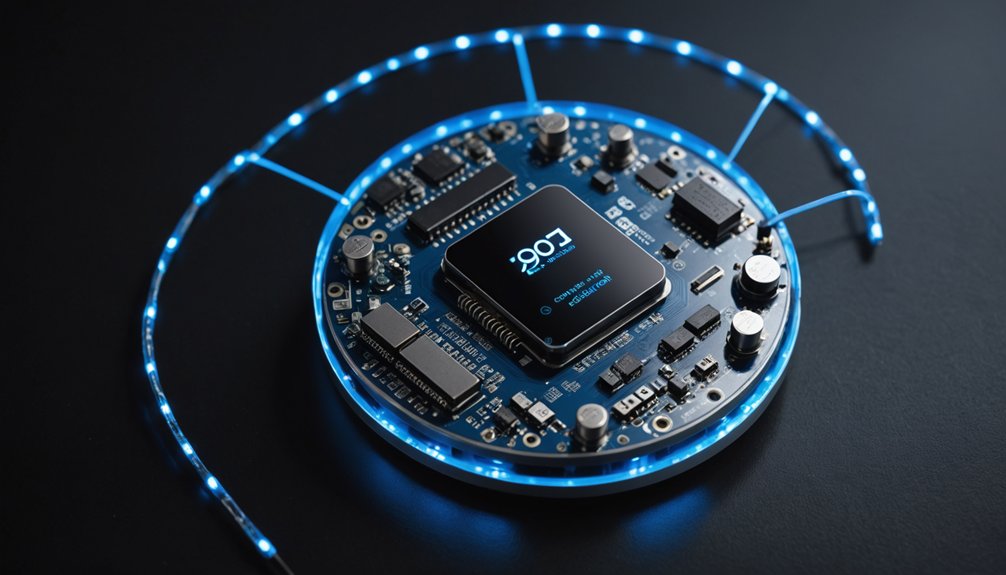Edge AI brings intelligence directly to IoT devices, eliminating the need for constant cloud connections. It's revolutionizing data processing by enabling real-time decisions right where the data originates. Smart homes, industrial machinery, and autonomous vehicles now make split-second choices without waiting for distant servers. This tech reduces latency, enhances privacy, and cuts bandwidth costs—all while using minimal resources. Edge AI isn't just fancy tech jargon; it's the backbone of our increasingly responsive digital world.

As technology races forward at breakneck speed, Edge AI has emerged as a game-changer for Internet of Things devices across industries. This revolutionary approach deploys AI algorithms directly on edge devices like smartphones and IoT sensors, rather than relying on distant cloud servers. The result? Lightning-fast processing without the annoying wait times we've all come to hate.
Let's face it – nobody likes lag. Edge AI tackles this head-on, processing data locally and delivering insights in real-time. This isn't some minor improvement; it's expected to handle 75% of all data by 2025, up from a measly 10% in 2021. Talk about scaling up fast.
The future is local—Edge AI is transforming 10% to 75% of data processing in just four years.
The benefits are obvious. Reduced latency means instantaneous decisions. Privacy gets a serious boost because your data stays put instead of bouncing around the internet. Bandwidth costs drop. Security improves. Devices keep working even when the internet doesn't. No brainer, right? These systems utilize autonomous agents to continuously monitor and adapt to changing conditions.
Applications are everywhere. Smart homes analyze sensor data without missing a beat. Industrial machinery makes split-second decisions that keep workers safe. Autonomous vehicles process essential information locally – because who wants their self-driving car waiting for the cloud before deciding not to hit a pedestrian? Wearable devices like smartwatches use local processing capabilities to continuously monitor health metrics without cloud dependency.
The technical advantages make sense too. Edge AI runs on devices with limited resources. It's energy efficient. Models execute faster during inference. And it scales beautifully across massive IoT networks. Plus, it plays nice with 5G. Machine learning algorithms are continuously optimized by AI trainers to ensure peak performance on edge devices.
Of course, it's not all sunshine and rainbows. Security remains imperative – these devices need robust protection, network segmentation, and solid encryption protocols. Both hardware and software solutions must work together, often implementing SASE for consistent security.
The impact on industries has been profound. IoT markets are expanding rapidly as Edge AI enables capabilities previously unimaginable. Manufacturers deploy it for defect detection. Healthcare wearables monitor essential signs without cloud dependency. Smart cities run more efficiently with real-time urban management through processing of data from numerous sensors and cameras.
Edge AI isn't just coming. It's here. And it's changing everything.
Frequently Asked Questions
How Does Edge AI Differ From Traditional Cloud-Based AI?
Edge AI processes data locally on devices, while cloud AI relies on remote servers.
The difference? Speed and privacy, basically. Edge AI delivers real-time decisions with lower latency. No internet needed. Private data stays put.
Cloud AI offers more computational power and scalability, but requires connectivity.
Edge AI wins for battery life too—it's just more efficient.
The tech world's buzzing about hybrid models now. Best of both worlds.
What Are the Power Consumption Challenges for Edge AI Devices?
Edge AI devices face serious power hurdles. Limited battery life restricts complex operations—you can't run fancy algorithms when your device dies in an hour.
Processors are deliberately constrained to save power. Heat buildup is a nightmare in tiny gadgets. Size limitations mean smaller batteries.
The whole system must balance performance versus energy use. Engineers rely on tricks like model pruning and quantization. It's a constant battle against physics.
How Secure Is Data Processing on Edge AI Devices?
Data processing on edge devices offers strong security advantages. Local processing limits data exposure and transmission risks. Period.
Edge AI employs federated learning to maintain privacy without sharing raw data. But challenges exist. Limited computational power hampers robust security implementation.
Physical access to devices? A major vulnerability. Data poisoning attacks remain a threat.
Encryption, secure enclaves, and hardware-level features like TPMs help mitigate risks. Still, no system's bulletproof.
Which Programming Frameworks Are Best for Edge AI Development?
For edge AI development, TensorFlow Lite stands out—optimized specifically for resource-constrained devices.
PyTorch Mobile gets the job done too. No surprise, framework choice depends on hardware compatibility and performance needs.
TensorFlow's ecosystem is massive, but don't sleep on Caffe for vision tasks. Smaller frameworks like OpenCV can work wonders when paired with the right tools.
Hardware compatibility trumps popularity every time.
What Certifications Are Required for Commercial Edge AI Deployments?
No single universal certification is "required" for commercial Edge AI deployments.
Industry recognizes several valuable credentials. The Linux Foundation Certified Edge Developer and Edge AI Vision Alliance certifications offer solid validation. IBM's AI Engineering and CertNexus AI Practitioner certificates also carry weight.
These aren't mandatory, just helpful. Companies care more about proven implementation skills than paper credentials. The field's too new for rigid requirements.
Results matter most.




